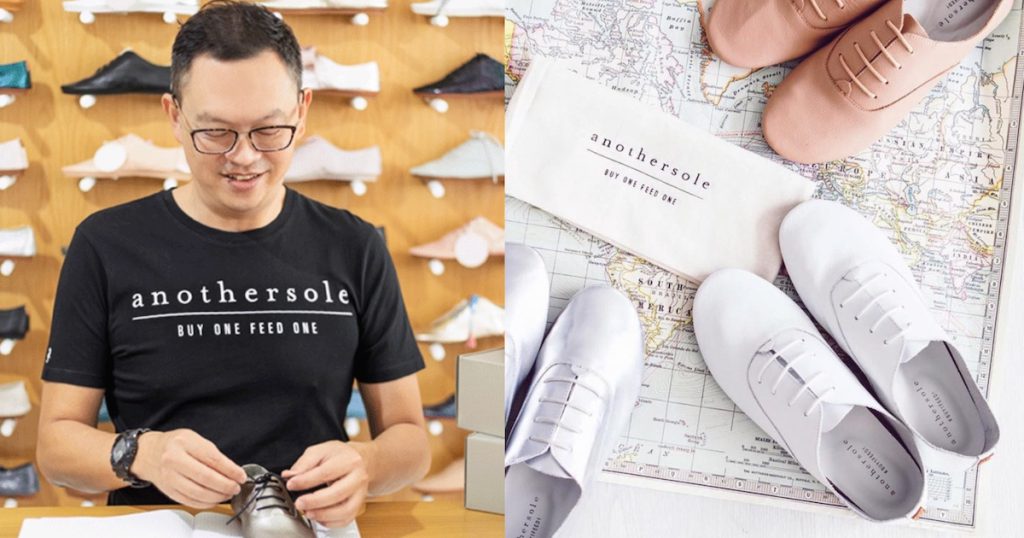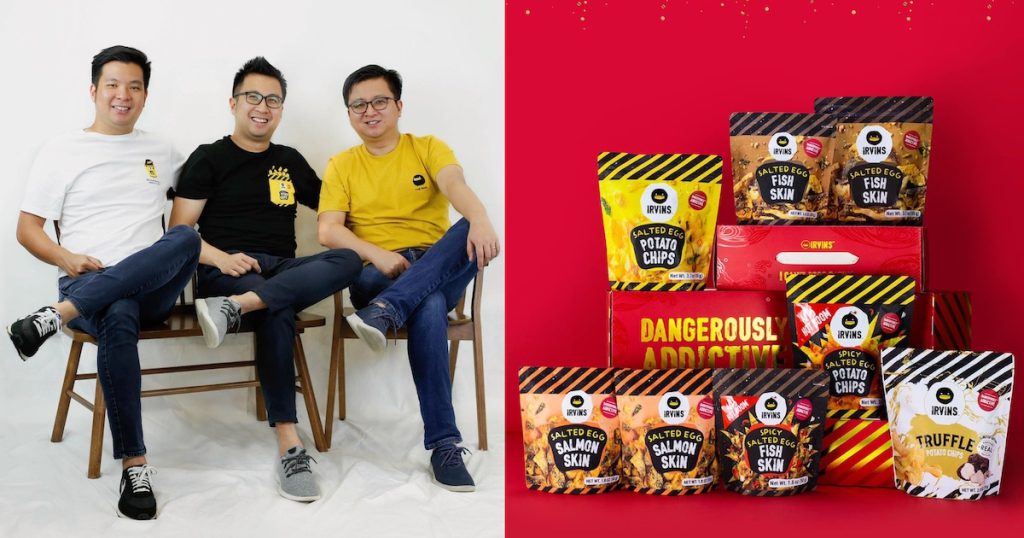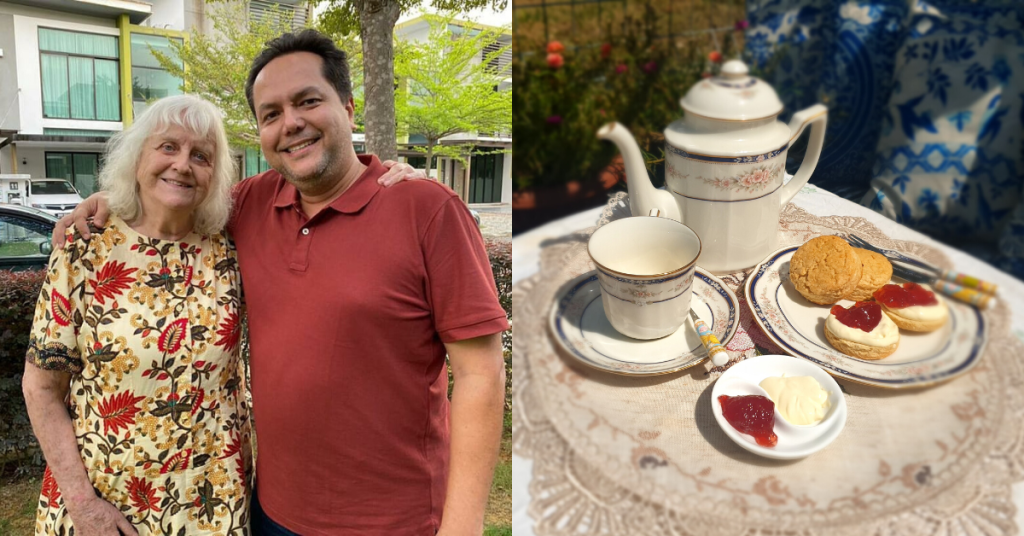Anothersole: This S’pore startup created the perfect flats – grew over 400% in 2 years

Anothersole, a footwear brand founded by Benny Chee and Phoebe Charn in 2016, has quickly made a name for itself in Singapore.
The two entrepreneurs, both age 50, first met at church and have been business partners since 2000.
After Benny completed his National Service, he entered the insurance industry with the goal of saving up for his university fees. But after venturing into starting his own business, he ultimately decided not to pursue his studies.
Benny, with a background in engineering, and Phoebe, with a background in fashion, have extensive knowledge of the footwear industry. Besides Anothersole, they manage another business, which designs and supplies footwear to chain stores globally since 2003.
The idea for Anothersole was sparked by the need for comfortable shoes that were also stylish. Many comfort shoes on the market suffer from poor aesthetics, and the founders set out to challenge themselves to develop the perfect flats that combine sports technology and leather craftsmanship.
These shoes had to be perfect for travel and daily commute, yet provide adequate support. It wasn’t easy, but they succeeded in creating the perfect shoe that strikes a balance between quality and comfort.
Creating the perfect pair of shoes
The R&D process at Anothersole is rigorous. They come up with many design iterations pre-production and are able to create many different variations of one construction.
Our Anytime lace-up flats are launched weekly with limited editions and we have up to 150 colours of the one style. Many of the limited releases are produced in small batches and we do not bring them back after they run out.
– Benny Chee, co-founder of Anothersole

They offer a variety of best-selling classic flats with pebbled textures and high durability, as well as its buttery-soft Lucie made with Argentinean leather. Its Paloma shoes are also popular, featuring luxury leather from Spain with soles that match the leather colours.
Benny added that they will soon announce a limited series of shoes made with premium leather used by a luxury brand.

Beyond its iconic flats, Anothersole has expanded its product line to include sneakers and bags for women, as well as sneakers for men.
This decision was driven by customer demand, as many of their customers own more than 10 pairs of Anothersole — the highest record being more than 40 pairs.
“We have loyal customers clamouring for new designs and we listened. We launched the men’s [line] because it is the women who are asking for it. They tell us their partners are complaining they don’t get to experience what Anothersole shoes feel like,” said Benny.
Pivoting from a footwear trading arm
One of the biggest struggles that Anothersole faced in the early days was building a scalable brand that was both financially viable and sustainable.
We started Anothersole when our footwear trading arm was at risk because buyers were going directly to the factories instead. We had to pivot or face business failure. A lot was at stake to make Anothersole work.
– Benny Chee, co-founder of Anothersole
With no external funding (it was fully self-funded by its sister company), Anothersole kept its costs low by operating leanly during its first year. With no proper office, they held weekly meetings in McDonald’s for close to a year.
The team never once complained. Everyone was dedicated to making Anothersole successful, and till today, Benny remains grateful towards those who have sacrificed and worked hard for the brand.
Its strategy for raising brand awareness, particularly in the early days, was centred around building trust with their customers.
They focused on communicating authentically and consistently, while actively engaging with its customers. By doing so, they were able to grow its Instagram following to over 50,000.
In addition to selling online and in department stores, Anothersole held frequent pop-ups and roadshows every other month to connect with customers and acquire new ones. Although it was challenging, it provided valuable business insights.

In October 2018, Anothersole opened its first physical store in Funan. This move was triggered by the company’s desire to be closer to its customers and offer them more convenient shopping options.
The omni-channel approach was a success and the company went on to open pop-up stores in various malls across Singapore, including Great World, Westgate, and PLQ Mall. This helped them to gather valuable insights into their customer demographics and led to the expansion of their current 10 retail points islandwide.
Business with a heart

Benny stated that Anothersole is currently financially independent and profitable, but their ultimate goal is guided by its purpose to make a difference.
Anothersole is known for its #Buy1Feed1 initiative, where 10 per cent of its profits are donated to serve children in need around the world and to help create a more sustainable future.
This is part of the company’s “Make Good, Do Good” philosophy, which is focused on creating high-quality products while also making a positive impact on the world. Benny believes that by choosing where to spend money as consumers and brands, we can collectively effect change and unlock resources for those in need.
Consumers, brands and governments can collectively effect change. Where we choose to spend our monies as consumers and a brand can have a downstream positive impact. This is very powerful. Imagine if all companies are united in this, what resources can we unlock from it?
– Benny Chee, co-founder of Anothersole
Grew more than 400% despite COVID-19

When the COVID-19 pandemic hit in early 2020, it brought about unprecedented challenges for businesses all over the world.
During the first two years of Covid with all the disruptions, it brought unprecedented challenges, from supply chain lockdowns to retail restrictions. Logistics cost shot through the roof, affecting margins and delivery timelines. It was a very difficult period for many — retailers were fighting landlords and there was a lot of uncertainty and fear.
– Benny Chee, co-founder of Anothersole
Rather than giving in to the challenges, Anothersole chose to focus on two things: taking care of its employees and customers.
“With the support of the team, customers and landlords during the dark ages of constant lockdowns, we went on a path of controlled expansion, bringing the number of retail points from three (pre-Covid) to 10 today,” Benny said.
He added that they have taken a leap of faith and invested in rolling out new channels across Singapore, as they identified opportunities in the market with premium space freed up as many overseas brands exited the market.
According to Benny, their acquisition push into the USA through a direct-to-consumer channel also saw revenue jump multifolds in the past 18 months.
Despite the bumpy journey, Anothersole has managed to grow by over 400 per cent over the past two years and expects to achieve record sales in the coming year.
Moving forward, Benny said that they will continue to operate with an “underdog mindset” and aim to grow sustainably.
Anothersole has ambitious plans to build the company into a purposeful and profitable enterprise. They are currently exploring opportunities to introduce Anothersole to more markets internationally, with the ultimate goal of becoming a globally recognised brand.
Featured Image Credit: PayPal / Anothersole
Also Read: Miss Tam Chiak partners S’porean chef to sell gourmet broths online – sales spike 3x every CNY
Asset recovery to regulation: Legal experts from Rajah & Tann comment on crypto law in S’pore

Despite the crypto downturn in 2022, interest in cryptocurrencies remains high in Singapore.
An OCBC study reported that millennials and Gen Zs remain bullish on the crypto market, with around 40 per cent of them still planning to invest in crypto within the next 12 months.
However, it’s not just investors who are becoming interested in the crypto market. 2022 saw advancements in government regulations surrounding crypto, and legal recognition of cryptocurrencies and NFTs as property.
As questions for what it means to hold or trade digital assets require a legal dimension, law firms have been setting up departments to deal with cryptocurrency lawsuits and Rajah & Tann — one of the largest law firms in Singapore — is no different.
Earlier this week on January 18, they held a seminar on cryptocurrency, and several lawyers who have been involved in cryptocurrency cases spoke about the state of cryptocurrency law, as well as its future.

The session was led by Jansen Chow, co-head of fraud, asset recovery, and investigations at Rajah & Tann, alongside other speakers including Justin Lee, a partner from the Technology, Media, and Telecommunications department, Yam Wern-Jhien, a partner from the fraud, asset recovery, and investigations department, and Samuel Lim, a partner from the financial institutions department.
Crypto assets are unlike anything the law has seen before
According to Yam, cryptocurrencies present a unique challenge when it comes to investigations and asset recovery.
For one, digital assets are not tangible. In many cases, tracking down stolen cryptocurrencies can mean having to trace corporate structures to see who holds which private keys to the wallet, before identifying where they are or compelling them to return to a place where the court has jurisdiction.
Unless this is done, Yam says that it can be virtually impossible to recover the assets in question.

To make things even harder, since not all companies have been following rigorous Know-Your-Customer (KYC) procedures, there are times when an investigation yields very little information.
We have had cases where we approach an exchange for information about an account, and we realise the account was opened by e-mail. Some accounts have hundreds of sub-accounts as well, and we have to find out who opened the wallet.
– Jansen Chow, co-head of fraud, asset recovery, and investigations at Rajah & Tann
All of this assumes that the exchange even decides to cooperate — some exchanges may choose not to reply to requests for information, or take a long time to attend to such requests.
Even after assets have been recovered, new questions arise as to what can or should be done with the assets.
The volatile nature of cryptocurrency prices presents new questions for us to think about as liquidators as well. Do we sell recovered assets? Can we be faulted for selling these assets too early?
In the cases when crypto assets are held on trust, do we provide tokens to claimants? Or should we provide fiat currency, and how much? All of these are new questions that we have to find answers for in the cryptocurrency industry.
– Jansen Chow, co-head of fraud, asset recovery, and investigations at Rajah & Tann
It’s not all bad news for lawmen
However, the transparency of crypto also presents new opportunities for investigators.
Transactions on the blockchain, while anonymous, are not private. Instead, they are publicly viewable, which means that during an investigation, investigators are able to track stolen funds in real-time, and freeze accounts that stolen funds are held in.
With fiat currency, the process was far more laborious. In the traditional way, you had to go to each jurisdiction to get an order of disclosure, which you then present to the bank.
The process is slow and ensures that we are always two steps behind when it comes to recovering stolen funds. Blockchain technology means that we can now monitor and directly freeze accounts.
– Jansen Chow, co-head of fraud, asset recovery, and investigations at Rajah & Tann
Beyond that, the trends within cryptocurrency crime also seem to indicate that the final destination for most stolen funds seems to be exchanges.

Fraudsters will often try to cover their tracks with ‘layering’. They send stolen cryptocurrency in small batches to different wallets, before sending them to an account registered with a cryptocurrency exchange.
The reasons why exchanges are so often selected as the final destination is because fraudsters need to realise their gains. Often, they want to convert stolen crypto assets into other assets, and exchanges often have the liquidity to help them with such conversions.
– Yam Wern Jhien, partner, fraud, asset recovery and investigation, Rajah & Tann
As such, Chow and Yam say that in cases where stolen crypto has not yet surfaced, a good strategy can be to simply wait for stolen funds to reappear on exchanges.
Attitudes within the cryptocurrency industry are also changing
Ultimately, these problems must be dealt with before a widespread crypto spring can come about, says Lee.
Given the high-profile crashes of crypto companies last year, he believes that investment in the cryptocurrency industry “will see a flight to quality and away from poor quality token projects”.
This means no more NFTs that are purely based on hype, or un-fun games that end up just being all about the grind to earn tokens for profit.

Instead, what we will see is an increased adoption of blockchain technology in established industries, where it will be used to enhance existing business models, or in the tokenisation of new asset classes.
Meanwhile, the industry can expect an increase in state regulations and adoption as legislation is already being considered in several major jurisdictions.
The European Union is set to vote on their landmark markets in crypto assets regulation in April, and the Australian Treasury is embarking on a token mapping project to identify, track, and record crypto activity within Australia.
“There will also be a need to address the information and transparency gap,” said Lee. “Mandatory disclosure requirements, due diligence service providers, and crowd-sourcing of information can help here.”
Lim notes that Singapore has not been idle in its regulations either. Crypto companies are mainly regulated under the Payment Services Act as Digital Payment Token Service Providers, and currently, there are regulations for anti-money laundering and KYC obligations
At the same time, however, the Monetary Authority of Singapore (MAS) has been trying to avoid seeming like it is legitimising crypto, which explains why its approach has been cautious.
MAS has consistently warned the public on the hazards of crypto, and has introduced guidelines for companies like prohibiting crypto companies from advertising their services. They also released two consultation papers on proposed regulatory measures for crypto companies last year.
– Samuel Lim, partner, Financial Institutions, Rajah & Tann
Lim expects that regulations on consumer access, business conduct, and market integrity may be put in place in the future. Crypto exchanges that have lax internal controls may soon have to draw up plans for proper risk management, and ensure that their private keys are properly kept as well.
Ultimately, it seems that the days of ‘yolo-polo’ style crypto companies are over. Instead, regulation and the rule of law are now in vogue.
Perhaps, it isn’t what crypto fanatics imagined when they spoke of how legal codes and regulators needed to catch up to crypto. But nevertheless, it is something that the industry sorely needs.
If a widespread crypto spring is to emerge, confidence in crypto companies must be restored, and regulations will be vital in bringing on board companies and consumers who have yet to express confidence in the new technology.
Featured Image Credit: Rajah & Tann
Also Read: Three Arrows Capital founders seek US$25M to fund new venture that aims to fill void of FTX
Privacy protection or intrusion? There’s a new tech that uses WiFi to see people through walls

Disclaimer: Opinions expressed below belong solely to the author.
As if we didn’t have enough concerns over privacy in this digital age, scientists at Carnegie Mellon University appear to have developed a technology for mapping humans in 3D using only WiFi signals.
They analyse their phase and amplitude, before feeding them to computer vision algorithms to produce an image, effectively “seeing” through walls and other obstacles.

The pre-print paper was published on arXiv three weeks ago and reported first by Vice this week.
As mentioned in the news reports, the efforts to detect or map humans without using expensive equipment such as Lidar have been going on for at least a decade. It seems they have finally produced fruit that may find practical use, though it’s hard to say whether it’s going to benefit us more than, possibly, harm.
Curiously, the authors themselves tout the technology as one that could be used to help, rather than hurt privacy:
In addition, they [WiFi signals] protect individuals’ privacy and the required equipment can be bought at a reasonable price. In fact, most households in developed countries already have WiFi at home, and this technology may be scaled to monitor the well-being of elder people or just identify suspicious behaviors at home.
– “DensePose From WiFi”, J. Geng, D. Huang, F. De La Torre
I’m not convinced that the ability to see through walls, even if it produces a very general 3D image, coupled with a “reasonable price” serve to enhance our privacy, though.
DensePose itself came out of Meta’s AI research labs, originally focused on generating 3D representations of humans using RGB pixels of a flat image. Carnegie Mellon team took it a step further and used radio signals produced by WiFi networks instead of visible light spectrum.

Given how many devices we already have at home, the notion that someone could either cheaply hack or outrightly buy a device that could potentially use them to determine not only whether someone is inside, but locate them in the space, sounds more like a dystopian nightmare.
Of course, like all tech, it could be used for productive purposes, such as monitoring sick, elderly, children or even pets within the boundaries of the home to check in on them from a distance and/or determine whether they may need help.
This is something of increasing importance as many pensioners live alone and there are increased cases of someone dying without anybody noticing in Singapore.
It may also be used to detect intruders — a feature particularly handy in a large house or other properties, enhancing work of visual systems like CCTV, which could otherwise be disabled by criminals.
Nevertheless, in this particular case, privacy concerns are bound to outweigh potential benefits, what may give rise to technological countermeasures interrupting or isolating WiFi signal from penetrating walls and making its way out to unwanted guests.
Fortunately, it’s an early stage proof-of-concept rather than a market-ready solution, so it’s going to take some time before anybody puts together such a WiFi-spy scanner to sell it on Amazon. Thus, for now, you should still focus on making sure nobody hacked your indoor cameras first.
Featured Image Credit: “DensePose From WiFi”, J. Geng, D. Huang, F. De La Torre
Also Read: Cutting through the hype: ChatGPT is impressive, but it is not AI – and may never be
IRVINS’ revenue more than halved overnight due to COVID-19, but it has bounced back stronger

Established in 2015, IRVINS was founded by Indonesian-born entrepreneur Irvin Gunawan.
The snack business started out as a zi char restaurant at River Valley, where IRVINS’ initially sold salted egg potato chips and fish skin as a side dish on the restaurant’s menu, before offering it as a packaged snack that customers could buy over the cashier counter.
The snacks were so popular that its sales multiplied by five to six-fold, leading the entrepreneur to shut down the zi char restaurant and focus on growing the salted egg business.

Joined by his two brothers in 2015, the brand saw profound success, so much so that it expanded to 14 markets around the world — that is, until the pandemic hit.
Shutting down half of its outlets in Singapore
When more stringent Circuit Breaker measures kicked in back in April 2020, IRVINS’ physical outlets were not allowed to operate given that it only sold snacks.
These measures spelt bad news for the company, as the main drivers of its business before the pandemic were its physical retail stores and e-commerce store.
While its revenue from its website remained steady, its retail store closures saw the business lose significant revenue that year. In fact, their sales more than halved almost overnight.
“It was a challenging time for the company, to say the least,” said the 36-year-old founder.
Furthermore, the travel restrictions imposed during the pandemic exacerbated the company’s revenue loss as the brand was a favoured snack for travelers to lug back home.

Scrambling to cut down on costs to cope with its losses, the company had to carry out a one-time retrenchment of over 30 staff and streamlined its facilities. This led to the closure of six of its 12 retail outlets, as well as its two-in-one restaurant concept Messy Kitchen by the end of the pandemic.
Working with retailers to make up for its losses
Up until 2019, IRVINS’ products could only be purchased via its stores or website. “So when COVID-19 hit, our customers were finding it hard to buy our products,” said Irvin.
This prompted the brand to work with retailers and other players in the F&B industry to boost its sales, which Irvin deems as a necessary move.
We had to learn to adapt by working with new local retail partners like 7-Eleven, RedMart, Cold Storage, NTUC Fairprice, international distributors and other businesses.
– Irvin Gunawan, founder of IRVINS
The brand took its partnerships with local retailers a step further by expanding it on an international scale — it now sells its snacks at 7-Eleven stores in Hong Kong and Taiwan, Costco in the US and Canada, and Don Quijote (Don Don Donki) in Japan.

Aside from retailers, IRVINS also collaborated with restaurants to “push the needle in creating new, innovative products” for its customers.
Its first collaboration was with local pizza chain Pezzo, in which they concocted a one-of-a-kind salted egg pizza. Although the pizza was available for a limited time, Irvin said that it was well-received by Singaporeans.
Such partnerships have proved to be vital to the company’s survival. By leveraging the customer base of its partners as well as its own, the company’s sales grew in volume over the past two years, and Irvin expects this upwards trend to continue this year.
It recently opened three new outlets in Singapore
As restrictions are lifted and more businesses sprung back to life this year, IRVINS’ physical store revenues are now back on track.
By diversifying its distribution channels during the pandemic, the company is in a more resilient position thanks to “the foundation of [the company’s] hard work over the past two years”, said Irvin.

In fact, IRVINS opened up three outlets last December — located at VivoCity, Bugis Junction, and Changi Airport T2 transit. According to Irvin, the brand does not intend to increase its number of outlets in Singapore for the time being.
“Running physical stores means we can’t shy away from manpower issues — a huge and common competitive problem among other retailers and F&B operators,” he explained, adding that inflation has become an additional concern.
For its new store openings, IRVINS faced hiring difficulties which impacted its store efficiency, as some stores could not operate at two full shifts.
As a consequence, the brand has to stay on top of its game and adapt to the hiring challenge in the retail and F&B space, by automating some of its processes and training store employees to take on hybrid roles.
In addition to that, IRVINS is also currently looking at exploring and working with tertiary institutions such as ITE to provide internship programmes for their students with possible career progressions within the company.
Ultimately, the brand’s vision is to solidify its Singapore HQ as an innovation center, and it is open to shifting its production out of the country to achieve this.
Expanding its international presence
This year, IRVINS plans on strengthening its business internationally, particularly expanding its distribution in the UK and Europe.
Commenting on IRVINS’ current international presence, the entrepreneur said that they have a sizeable presence in countries such as the Philippines, Hong Kong, and most recently, the USA.
“We have built a certain business and brand reputation in [these] markets, and our products can be easily found in local stores.”
Despite this, IRVINS still faces major obstacles expanding overseas, such the lack of “awareness and education” in the majority of overseas markets.
Unlike Singapore, not many people know about or have tried salted egg and fish skin as a snack. This naturally and directly impacts the way IRVINS has to market our products.
– Irvin Gunawan, founder of IRVINS
Hence, the company has to come up with effective ways to convince potential customers abroad to try its products. For example, in the US, the company first started to build its presence in Asian communities since they figured that Asians would be more familiar with the salted egg concept.

The brand is now popular in Los Angeles, San Francisco as well as New York, and it plans on moving into mainstream markets by selling its products through Costco and Albertsons supermarkets across the country this month.
Additionally, although IRVINS has pulled the plug on Messy Kitchen in Singapore, it plans to revive it abroad, so its global customers can have a taste of IRVINS’ signature salted egg on cooked food.
“This is the closest experience they can get to the time we were a [zi char] restaurant,” said Irvin.
He believes that there is so much potential to explore and create new products using its salted egg recipe.
With a commitment to innovation, IRVINS has plans to introduce new products in the coming years. These new offerings may include customisable options, fresh food infused with IRVINS’ salted egg recipe, and improved store concepts.

Even though the company has already expanded its product line with other offerings such as Smoked Cheese Salmon Skin and Truffle Potato Chips that deviate from salted egg flavours, customers have continued to love these new products just as much as the original salted egg line-up.
This positive reception has humbled the founder and signifies to him that IRVINS has an appeal beyond its salted egg flavours and motivates the company to move forward.
Featured Image Credit: IRVINS
Also Read: Meet The Man Behind Irvins: How He Built A Global Salted Egg Empire From A Zi Char Eatery
English clotted cream is a niche product, yet this M’sian has dedicated 14 years to it

Try ask any Malaysian you meet on the streets if they know what English clotted cream is and chances are, they wouldn’t.
From its name alone, you could probably guess that it’s a dairy-based product from England, but what could it possibly look like, much less taste like?
If it’s still this rare and unfamiliar now, imagine how impossible it would’ve been to find over a decade ago. Hussein himself learnt this first-hand in 2009.
He had been searching high and low but could not find the one item of his desire to eat with scones—English clotted cream.
Instead of giving up though, he rolled up his sleeves and made his own. That was the start of Jozie’s Homemade Clotted Cream (Jozie’s). But you might still be thinking…
So what is English clotted cream?
English clotted cream (also known as Devonshire or Cornish cream) is a clotted cream that hails all the way from England.
A thick, rich, and yellowish cream made from unpasteurised milk, this cream is unlike anything that you’ve probably had with scones locally.
“I found it very frustrating that most cafes here in Malaysia served scones either with just butter, or at best, with fresh whipping cream,” Hussein said.
Equipped with a background in the hotel culinary industry, he started experimenting in his own kitchen. Countless recipes were tested with different dairy ingredients for two years, until one day, he successfully whipped up the perfect batch of clotted cream.
“[It] resulted in me gaining a few more inches around the waist,” Hussein joked. “I finally came up with what my mother (Josephine, or Josie), who is English, would say is 90% close to the real thing.”

Image Credit: Jozie’s Homemade Clotted Cream
Whipping up the business
Figuring that others might be interested in trying his clotted cream, Hussein began posting about it on his blog.
This was a strategic move on his part as the blogging sphere back then was much more active than it is today. Orders came flooding in and Hussein’s side business was launched.
Then called MY Devonshire Homemade Clotted Cream, the brand has since changed its name to Jozie’s Homemade Clotted Cream. This personal touch serves as a tribute to his mother (nicknamed Josie by his grandparents) and reflects the history and tradition of the product.
“She had fond memories of having tea in Devon with granny and granddad, which included home baked scones, Devonshire clotted cream, and strawberry jam. Jozie’s Homemade Clotted Cream is dedicated to that memory,” Hussein explained.
His first big break came in 2014 when Janet, the owner of Tipsy Brew O’Coffee, sent an SMS to enquire about his clotted creams. Since then, Jozie’s Homemade Clotted Cream has also been supplying Janet’s second venture, 23.5 Coffee Roastery.
Following that, he was approached to form a partnership with Kenny Hills Bakers in 2020. Hussein now supplies to all of its six outlets. So if you ever visit any of these establishments, just know that the clotted cream being served with your scones is by Jozie’s.
“Having it will bring back memories of those who have had the real thing in the countryside of Devon and Cornwall. The trick here is to have lots of it,” Hussein shared.

It pays to be prepared
Although new to the F&B entrepreneurial industry, Hussein did not go into the clotted cream business empty-handed.
His past experience as the dealer for an “as seen on TV” business and other innovation-related ventures guided him. His involvement in MACRI (Malaysian Association of Creativity & Innovation) since 2007 also gave him the confidence needed to build up Jozie’s Homemade Clotted Cream.
“My belief is that this is my calling… to be involved in innovation,” he remarked.
The clotted cream he made 14 years ago is a testament to this. Through improvisation and adaptation of the traditional recipe, he was able to craft one that better suited what we like here.
“I think [it] would surprise the English people. I guess it’s like finding out there’s a type of ‘belacan’ that’s made in England,” Hussein joked.
Despite the slight differences in texture, the end product of Jozie’s Homemade Clotted Cream is said to taste “just the same”. Some of his repeating customers include expats who have vouched for this claim.

There’s more to come
Jozie’s Homemade Clotted Cream is currently sold online together with scones and jams that are also made locally. As for the ingredients, only the ones from GMP, HIACC, and halal-certified manufacturers are used.
This rare English condiment that was once made in Hussein’s home kitchen is now produced at a dedicated shoplot outlet. Located in Bandar Saujana Utama, the name Jozie’s Kitchen is another ode to his dear mama.
He remains the frontman and is supported by family members and one full-time staff. The small scale of this business has allowed him to continue his work as a trainer in the realm of creativity and innovation, and Hussein has already proven his dedication to continue creating English clotted cream.
Acknowledging that Malaysia has a relatively small market for English clotted cream, he’s looking to ramp up production capability to first cater beyond the greater Klang Valley. His bigger goal is to venture past our borders and make this his full-time business.
“Starting with Singapore, Australia, New Zealand, and beyond. Who knows, Jozie’s Homemade Clotted Cream might one day be available in Harrods, London in the not-too-distant future. That would make a great story, wouldn’t it? Malaysia Boleh!”
- Learn more about Jozie’s Homemade Clotted Cream here.
- Read other articles we’ve written about Malaysian startups here.
Also Read: Hopping into a festive Peranakan house, what does a DJ rabbit have to say about CNY?
Featured Image Credit: Jozie’s Homemade Clotted Cream
US-based gaming commerce biz looks to fill new KL office with local talents in these roles

Xsolla, a video game commerce company headquartered in the US, has officially opened its new Kuala Lumpur office. This Malaysian location will reportedly be Xsolla’s largest office outside of Los Angeles.
Although the grand opening happened recently, the company has been in the process of setting up shop and hiring talent as far as 10 months ago, according to LinkedIn posts from HR personnel.
From indies to AAA+ games, Xsolla provides payment services in the video game industry, offering over 700 local payment methods worldwide.
This means many developers and publishers globally use Xsolla to help make their games accessible.
Names it has partnered with include well-known giants such as Ubisoft, Atari, Roblox, Epic Games, and Steam, among other companies.
Other than payment methods, Xsolla also offers a range of different solutions to help video game companies fund, distribute, market, and monetise their games.
Choosing to expand from Malaysia
According to a Techwire Asia article, the president of Xsolla, Chris Hewish, said that the video game commerce company chose Malaysia because of its rapidly growing gaming market and strong gaming ecosystem.
The Techwire Asia article also cites the local appetite for games, thriving esports scene, and talented workforce as reasons why Malaysia made for an ideal location for Xsolla.

Xsolla was also supported by MDEC (Malaysia Digital Economy Corporation) and the government’s initiatives to grow the games industry.
MDEC posted on LinkedIn that this expansion into to Kuala Lumpur is in line with the growing number of gamers and mobile game companies in Asia.
Hiring local talent
According to Konstantin Golubitsky, the CEO of Xsolla, the KL office aims to become 300 team members strong by the end of the year in order to contribute to the region’s growing gaming industry.
To hit this target of theirs, Xsolla currently has quite a number of job openings available right now.
These job openings are open to all local applicants, which includes citizens or those with PR status in Malaysia.
Here is a list of the job openings at Xsolla:
- Developers: Backend Developer (Payments Team), Backend Developer (Payments Team) – PHP, Full Stack Developer (Senior Level), Middle/Senior Golang Developer (Funding), PHP Developer (In-Game Services Team), Flow Developer (Operational Intelligence), Full-stack NodeJS/React Developer (Mid-Level)-CRM TEAM, Middle/Senior React Developer (Funding), PHP Developer (Webshop Team)
- Finance department: Finance Analyst (Internal Bonus System),
- IT department: Database Administrator, Senior Database Administrator, DevOps Engineer
- Product managers department: Product Owner (Documentation), Associate Product Manager
- Marketing department: Product Marketing Manager, Graphic Designer
- Research and development department: Tech Lead PHP (Payment), Technical Lead (Funding), QA Engineer (Webshop Team), QA Engineer (Payment Team)
- Others: Assessor, Customer Support Representative, Business Analyst (Operational Intelligence), Middle Data Analyst, Technical Director (Director of Development Hub)
Also Read: Hopping into a festive Peranakan house, what does a DJ rabbit have to say about CNY?
Featured Image Credit: Xsolla